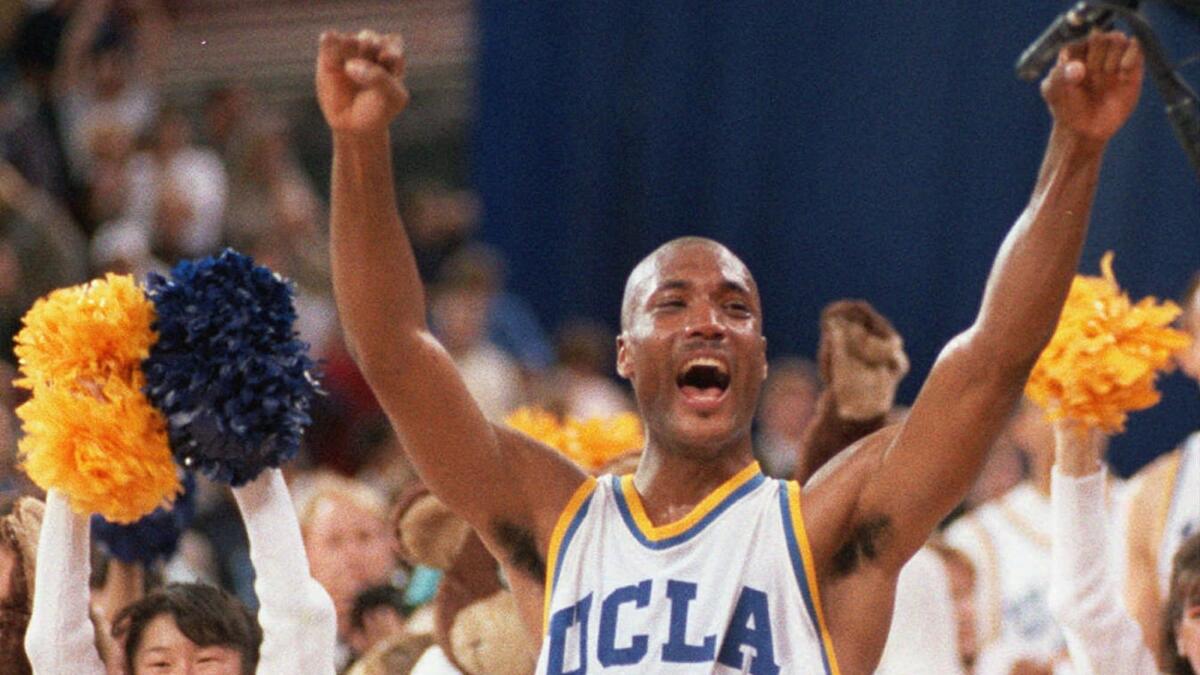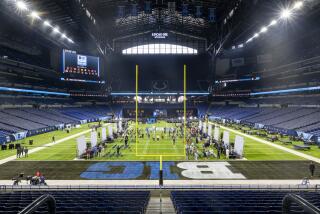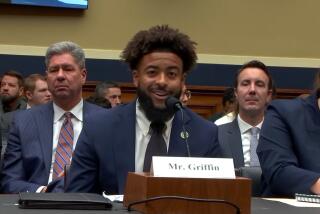Column: NCAA threatens California over pay for college athletes — and loses the battle

It’s always fun to see a bully get upended in the schoolyard. So we should be grateful to the NCAA for providing us with such a spectacle in Sacramento — and for demonstrating, in the process, its increasing irrelevance.
The issue on which the National Collegiate Athletic Assn. tried to bully the California Legislature involves pay for student athletes. More specifically, it’s whether student athletes should be compensated for the use of their “name, image or likeness” (often abbreviated as NIL).
We’re talking about publicity photos, video games featuring real-life players for authenticity, game-day telecasts, highlight clips and so on. The NCAA doesn’t allow student-athletes to be paid for these rights. But it’s what the Fair Pay to Play Act, which has been passed by the California State Senate and awaits action in the Assembly, would allow.
They’re trying to scare my colleagues. But so far, it hasn’t worked.
— Sen. Nancy Skinner (D-Berkeley), speaking of the NCAA
The NCAA seems to think that such a change would bring the whole edifice of intercollegiate athletics crashing down. That was the implication of a bullying letter its president, Mark Emmert, sent two Assembly committee leaders on June 17.
The legislation, Emmert warned, “threatens to alter materially the principles of intercollegiate athletics.” He said this would “make it impossible to host fair national championships.”
If you’re reading between the lines, Emmert effectively threatened to bar California universities and their athletes from NCAA competition. He said the organization had created a working group just a month ago to study the NIL issue, and he asked for time for the panel to ponder and report. How much time? The California measure wouldn’t take effect until 2023, which sounds like plenty.
To outside observers, Emmert’s plea is merely a “delaying tactic,” in the words of Ellen Staurowsky, an expert on sports management at Drexel University. “The NCAA has had ample time to address the issue … and they have failed to do so at every turn.”
There’s a lot of sophistry packed into Emmert’s letter. But let’s start with the threat, which didn’t sit too well with Sen. Nancy Skinner (D-Berkeley), the measure’s sponsor.
“They’re trying to scare my colleagues,” she told me. “But so far, it hasn’t worked.” (The Assembly Arts, Entertainment, Sports, Tourism, and Internet Media Committee approved the bill Tuesday by a 5-0 vote and sent it on to the Higher Education Committee.)
“Big businesses make threats a lot,” Skinner says. “Amazon made incredible threats when we carried the bill to require them to collect sales tax [in 2011], and they’re thriving in California. Corporations up and down the state said they’d leave when we demanded gender pay equity [in 2015]. We’re bolder on climate protection than anyone and there were threats of job loss and economic doom when we adopted that, and we’re still the fifth-largest economy in the world. So we withstood all of those without doomsday consequences. We lead, and we lead with our values.”
That’s not even to mention the emptiness of Emmert’s threat. Do you really think the NCAA is prepared to exclude such big fan draws as UCLA, Cal, Stanford and USC from its championship slates? Me neither.
The question of NIL compensation is part of the larger issue about the role of student-athletes in college sports, especially the big-money sports of men’s football and basketball.
The NCAA, Staurowsky says, long has tried to “stall progress on creating a fair compensation system that acknowledges rather than suppresses the value of the college athletes who serve the economic engine of the college sport industry.”
Truly, the NCAA presides over a system that generates huge payouts for many participants. Coaches get multimillion-dollar salaries; universities collectively glom onto billions of dollars from television deals, booster donations and rentals of luxury boxes at campus stadiums, the costs of which are reaching toward a half-billion dollars. Emmert himself collected a healthy $3.9 million in compensation as NCAA president in 2017, the latest year reported.
Who’s deprived of a piece of the action? The student-athletes, who put their health and lives on the line to feed everyone else at the trough.
The NCAA positions itself as guardian of the sanctity of the amateur student-athlete — placing the “highest priority on the overall quality of the educational experience,” to quote its bylaws.
This may be germane to the vast majority of participants in intercollegiate sports, especially participants in small-money athletics and benchwarmers in the big-money sports. But otherwise, it sounds like ghastly sarcasm.
How does the “educational experience” apply to programs that have suborned their academic standards to keep players on the football and basketball rosters, like the University of North Carolina and Syracuse University, where administrators faked coursework and staged bogus classes for players — for years, even decades?
How does it apply to one-and-done basketball programs like those of Duke and the University of Kentucky that stack their rosters with kids playing out a year of post-high school ineligibility before jumping to the National Basketball Assn.?
The NCAA has pursued its self-defined mission of preserving amateurism in college sports in part by keeping the athletes indentured. For a time, the organization barred schools from providing scholarships to recruits valued at more than tuition and fees, room, board and textbooks.
But that left low-income students short of funds for the full “cost of attendance,” including incidentals. Absurdities proliferated, as when Boise State had to seek special permission to provide a homeless football recruit with lodging before he made it to campus, or a basketball player at the University of Connecticut reported sometimes going hungry. In 2014, the NCAA capitulated to reality (and a judge’s order) and permitted schools to provide athletic grants-in-aid up to the full cost of attendance.
The organization’s claim that the valor and value of student-athletes required depriving them of compensation for the exploitation of their names, images and likenesses failed to sway Federal Judge Claudia Wilken of San Francisco, who called foul on the NCAA’s “malleable” definition of amateurism in 2014. She was ruling in favor of former UCLA basketball star Ed O’Bannon in the lawsuit he brought over payment for the use of his likeness in a video game.
The NCAA rules permitted a tennis recruit to collect $10,000 in prize money before he enrolled in college, but stripped a track and field recruit of eligibility for doing the same, Wilken noted. A football player could accept a federal Pell Grant that brought his scholarship totals higher than his cost of attendance but would be ruled no longer an amateur if he refused the Pell Grant and instead accepted the same sum for his name, image and likeness in a game telecast.
“Such inconsistencies are not indicative of ‘core principles,’” she ruled.
Wilken gave O’Bannon and fellow plaintiffs in his class action a partial victory — ordering that the NCAA allow athletes to accept grants up to the cost of attendance along with deferred NIL payments of no less than $5,000 a year. In 2015, an appeals court upheld the cost-of-attendance rule but threw out Wilken’s order on deferred NIL payments.
The NCAA is still trying to hold the line on just compensation for players. While patting himself on the back for creating the working group on NIL compensation, Emmert in his letter specified that “concepts by which student-athletes are considered employees and paid for their athletics participation will not be considered” by the panel. The group comprises 16 university and conference representatives, and three students, which hints at how it may lean.
The NCAA must be aware that the ground is shifting beneath its feet. It’s just hoping to remain upright indefinitely. In 2014, a regional office of the National Labor Relations Board ruled that Northwestern University players were employees, opening the path to their unionization. The full NLRB effectively overturned that ruling, but its Obama-era general counsel backed it up in principle. He’s gone now, but his argument is certain to gain support, over time (even if over a long time).
The Olympics, once a bastion of “amateurism,” have redefined the term to accommodate athlete compensation and even the creation of Olympic basketball teams composed almost entirely of professional players. If the NCAA holds to its stringent definition of amateurs, it’s destined to become increasingly isolated.
The organization’s denial of NIL compensation can’t be reconciled with basic civil rights. “This is a right that all the rest of us have, and Olympic athletes have,” Skinner says. “Imagine if in any other billion-dollar industry, like TV and movies, college students were the primary source of the talent that generated the revenue for that business and those college students were completely denied compensation. There would be a universal outcry. And yet we say it’s OK for athletes.”
Emmert called in the letter for the NCAA and its members to “constructively engage,” which might be difficult if he’s holding the threat of exclusion from national championships over colleges’ heads. And he hauled out that all-purpose argument for doing nothing that would discomfit the powers that be: The bill “likely would have a negative impact on the exact student-athletes it intends to assist.” (I.e., by prompting the NCAA to ban them from national championships?)
He also failed to acknowledge the curious timing of the working group. It was announced May 14, as Skinner’s bill was moving through committee. (It was passed by the Senate on May 22 by a vote of 31 to 5.) That’s a sign that the NCAA is becoming a tiger made of paper of increasing flimsiness. It can be pushed around, if its adversaries only understand that it substitutes bluster for substantive policymaking.
Emmert’s letter did nod to the 2023 effective date of Skinner’s bill, but said that’s a bad thing, as its passage now “will create confusion among prospective and current student-athletes…. The impact of a prematurely passed bill would be difficult to untangle.”
Well, good. The only flaw in the bill is the too-distant time frame. Skinner says she wrote it that way to give the NCAA and its member colleges “ample time to develop fair rules and to do what is right.”
She gives the NCAA too much credit. The only thing it understands is a full frontal assault. In this case, California should make the rules and let the NCAA tag along, as it must.
Keep up to date with Michael Hiltzik. Follow @hiltzikm on Twitter, see his Facebook page, or email michael.hiltzik@latimes.com.
Return to Michael Hiltzik’s blog.
More to Read
Inside the business of entertainment
The Wide Shot brings you news, analysis and insights on everything from streaming wars to production — and what it all means for the future.
You may occasionally receive promotional content from the Los Angeles Times.











